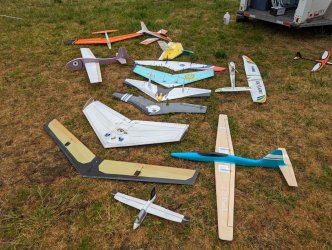Doc J
Very Strong User
Hi Guys,
I have long had a passion for slope wings, and also a really deep feeling that for slope racing - if done right - the plank or maybe the swept wing with BSLD would ultimately be the fastest solution ever.
I have made a few wings over the years and all were successsful in a limited way - though I have to say they were a bit 'wimpy' conservative lower A/R swept wing type.
In recent years it has become more and more evident to me that if you want the wing to go fast - swept or plank type - like all gliders you need the Aspect ratio.
So, anyway I'm working on a wing myself - well I should eleborate here - with Peter Wick who is about the best plank aerofoil designer there is, and collaborator Tobias Schiller. Frankly, Planks are really tricky in many ways and this single surface high aspect ratio requirement multiplies the design problems by several orders of magnitude.
I'm doing the overall design with specially designed aerofils from Peter and Tobias and I'm quite open in that I really need as much help as I can get, as this delves into a little studied arm of aerodynamics which really is quite specific, though also quite fascinating. I dont expect it will be a commercial success, although it will be available commercially - more to fulfill a dream.
Here is a video of a plank design by Peter et al: This is a small-ish 2.2M plank made by Drops and yes it is descending from a great height - though of course that begs the question of how it got that high in the first place without being pretty efficient. Take a look - this is the performance I'm looking for - or better - as mine is 3M...
http://www.vimeo.com/230416909
Seeing Nate's video of his Starfire at Sunset, plus Red's involvement, and my subsequent study of BSLD prompted me to divulge the present project - shows how nicely well designed wing CAN fly.
It can be done, it has been done and hopefully WILL be done.
Now...is it only me? - I'm wondering how many of us like wings for thier own sake.
Cheers,
Doc.
I have long had a passion for slope wings, and also a really deep feeling that for slope racing - if done right - the plank or maybe the swept wing with BSLD would ultimately be the fastest solution ever.
I have made a few wings over the years and all were successsful in a limited way - though I have to say they were a bit 'wimpy' conservative lower A/R swept wing type.
In recent years it has become more and more evident to me that if you want the wing to go fast - swept or plank type - like all gliders you need the Aspect ratio.
So, anyway I'm working on a wing myself - well I should eleborate here - with Peter Wick who is about the best plank aerofoil designer there is, and collaborator Tobias Schiller. Frankly, Planks are really tricky in many ways and this single surface high aspect ratio requirement multiplies the design problems by several orders of magnitude.
I'm doing the overall design with specially designed aerofils from Peter and Tobias and I'm quite open in that I really need as much help as I can get, as this delves into a little studied arm of aerodynamics which really is quite specific, though also quite fascinating. I dont expect it will be a commercial success, although it will be available commercially - more to fulfill a dream.
Here is a video of a plank design by Peter et al: This is a small-ish 2.2M plank made by Drops and yes it is descending from a great height - though of course that begs the question of how it got that high in the first place without being pretty efficient. Take a look - this is the performance I'm looking for - or better - as mine is 3M...
http://www.vimeo.com/230416909
Seeing Nate's video of his Starfire at Sunset, plus Red's involvement, and my subsequent study of BSLD prompted me to divulge the present project - shows how nicely well designed wing CAN fly.
It can be done, it has been done and hopefully WILL be done.
Now...is it only me? - I'm wondering how many of us like wings for thier own sake.
Cheers,
Doc.
Last edited:



